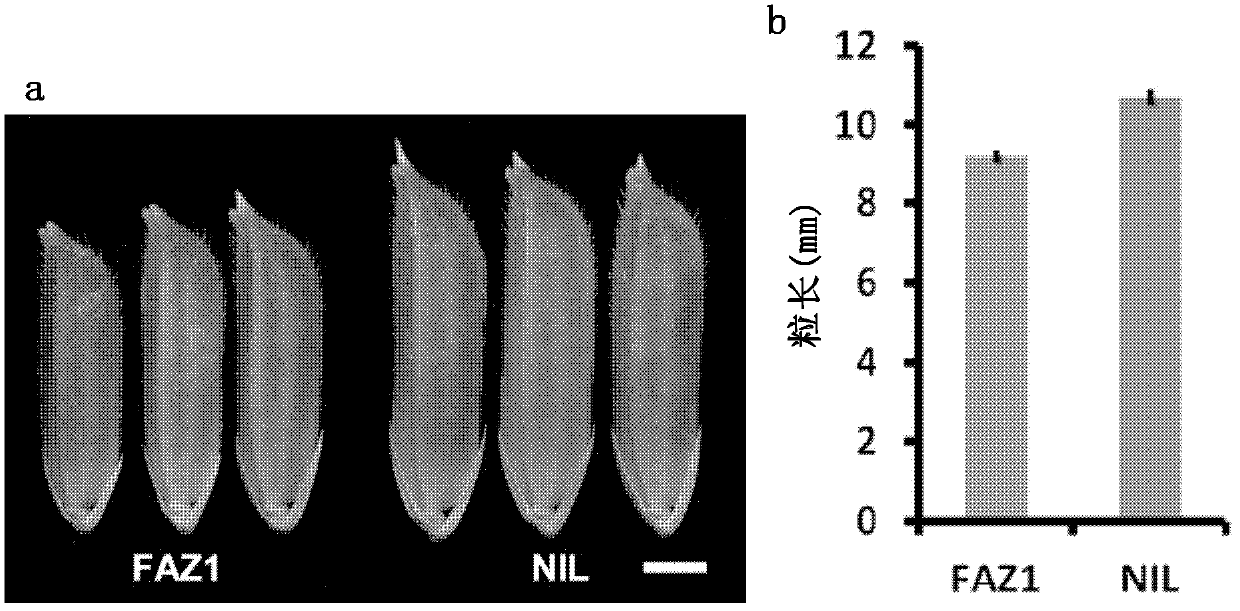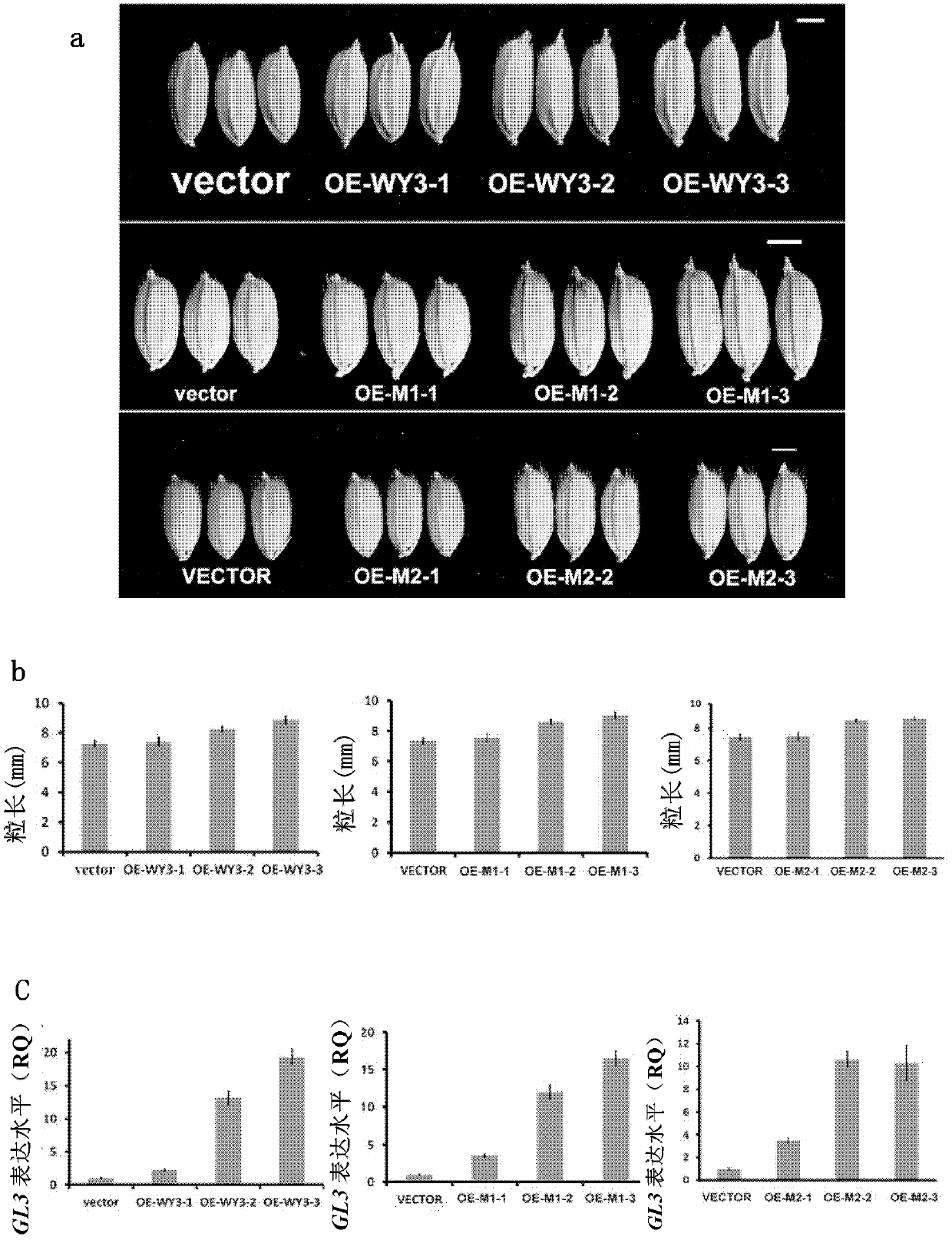Rice long-grain related gene and application for same
A technology of residues and amino acids, applied in rice long-grain-related genes and their application fields, can solve the problems of few genes to be cloned and studied in depth, and no breakthroughs in the cloning and research of rice long-grain-related genes
- Summary
- Abstract
- Description
- Claims
- Application Information
AI Technical Summary
Problems solved by technology
Method used
Image
Examples
Embodiment 1
[0114] Molecular marker-assisted selection breeding of embodiment 1GL3
[0115] Extract the DNA of the long / large-grain variety WY3 and the small-grain variety FAZ1, and design PCR oligonucleotide primers in the GL3 gene. The primer sequences are as follows:
[0116] 5' end primer: 5'-GGTCGTTGTTGTGTAAGG-3' (SEQ ID NO.: 11);
[0117] 3' end primer: 5'-TAGTGAAGATGGGTGCTG-3' (SEQ ID NO.: 12).
[0118] PCR amplification was carried out with Taq enzyme; the amplified product was digested with restriction endonuclease DraI, and the DNA polymorphism between the long / large grain variety and the small grain variety was detected by 1.5% agarose gel electrophoresis. The amplified molecular weight of the small-grain variety is about 1kb, and the amplified molecular weight of the long / large-grain variety is about 500bp, so the primers can be used as molecular markers to specifically identify the long-grain GL3 gene and the small-grain GL3 gene. The molecular marker can be used to quickly...
Embodiment 2
[0159] Embodiment 2 GL3 rice transgenic experiment
[0160] In this example, the commercially available binary expression vector pHB was used as the rice transgenic vector. The vector has a bacterial origin of replication (ori), a kanamycin resistance gene (Kan r ), hygromycin resistance gene (Hyg r ), herbicide resistance gene (Bar), CaMV35S promoter, termination signal sequence of NOS gene, and restriction enzyme cloning site (MCS). The cDNA of GL3 can be inserted forward or reverse into the restriction endonuclease cloning site to construct a transgenic plasmid.
[0161] Construction of transgenic plasmids for positive sense overexpression of GL3
[0162] In this embodiment, the RNA of the constructed long / large-grain and small-grain varieties is used as a template to synthesize the first strand cDNA, and the PCR oligonucleotides at the 5' and 3' ends of the DNA sequence are used as primers (SEQ ID NO.: 3 and SEQ ID NO.: 4), amplified with the high-fidelity Taq enzyme K...
Embodiment 3G
[0168] Embodiment 3 GL3 transforms rice
[0169] 1.1 Four kinds of recombinant plasmids prepared in Example 2 were introduced into Agrobacterium strain EHA105 (purchased from Biovector Company) by freeze-thaw method, the method is as follows:
[0170] Add 0.5-1 μg (about 10 μl) plasmid DNA to every 200 μl of EHA105 competent cells and mix well, place on ice, liquid nitrogen, and 37°C water bath for 5 minutes each; dilute to 1ml with fresh YEB liquid medium, and store at 28°C Incubate with shaking for 2-4 hours; take 200 μl and spread it on a YEB plate containing antibiotic Kan (50 μg / ml), and culture at 28° C. for 2-3 days. The grown colonies were marked on the YEB plate containing antibiotics for 3 consecutive times. Referring to the method of Hiei et al. (1994), pick a single colony of Agrobacterium from the YEB plate and inoculate it into 3ml of YEB liquid medium containing antibiotics, culture it overnight at 28°C with shaking, and transfer it to 50ml on the second day wi...
PUM
 Login to View More
Login to View More Abstract
Description
Claims
Application Information
 Login to View More
Login to View More - R&D
- Intellectual Property
- Life Sciences
- Materials
- Tech Scout
- Unparalleled Data Quality
- Higher Quality Content
- 60% Fewer Hallucinations
Browse by: Latest US Patents, China's latest patents, Technical Efficacy Thesaurus, Application Domain, Technology Topic, Popular Technical Reports.
© 2025 PatSnap. All rights reserved.Legal|Privacy policy|Modern Slavery Act Transparency Statement|Sitemap|About US| Contact US: help@patsnap.com



